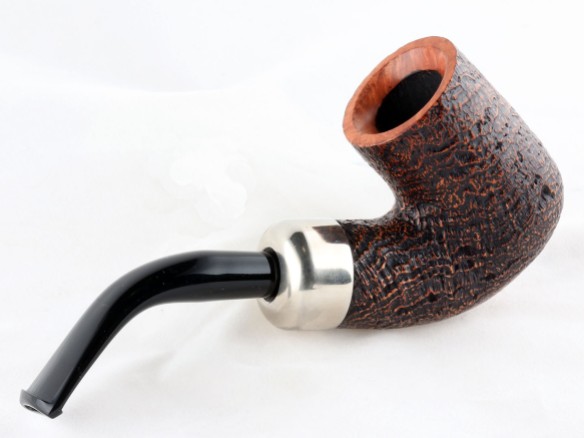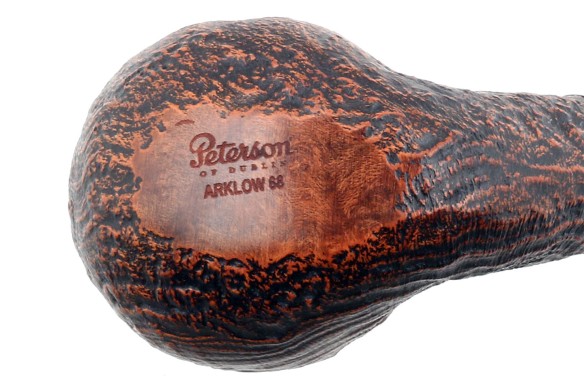72. The New Arklow Custom Line from Smokingpipes
 As we discuss in the book, Peterson has a long-standing tradition of customization and design collaboration that stretches back to the first decades of the company. This could be anything from a short run of a single pipe, like the 307 System sandblast currently available for pre-order from Cupojoes.com for the Pipe Smokers of Ireland Facebook club, to a commemorative like the 135 numbered pieces produced for the James Fox 135th Anniversary last year, to a full-fledged line for a large retailer like Laudisi (Smokingpipes.com). These special edition pipes are of great interest to Pete Nuts, and I always enjoy hearing about them and how they came about.
As we discuss in the book, Peterson has a long-standing tradition of customization and design collaboration that stretches back to the first decades of the company. This could be anything from a short run of a single pipe, like the 307 System sandblast currently available for pre-order from Cupojoes.com for the Pipe Smokers of Ireland Facebook club, to a commemorative like the 135 numbered pieces produced for the James Fox 135th Anniversary last year, to a full-fledged line for a large retailer like Laudisi (Smokingpipes.com). These special edition pipes are of great interest to Pete Nuts, and I always enjoy hearing about them and how they came about.
A few weeks back, one of the finest examples I’ve seen in a long time of a custom-line collaboration appeared at Smokingpipes, one that just begs to be seen all in one place. So I got in touch with Sykes Wilford at Smokingpipes and Conor Palmer at Peterson, who both modestly demurred that it was just part of the routine, but as you look at these pipes, I think you may find the Arklow line that came out of their collaboration is anything but.
According to Sykes, the 2011 sandblast Wicklow was the first Peterson-Laudisi collaboration. From the Smokingpipes website, it looks like the line underwent two or three iterations in color and finish before coming to a close around 2014. At some point since then, Laudisi also commissioned two further sandblast custom lines, the Aran sandblast and the Kildare sandblast. The latter was a collaborative effort between Sykes, Michael Walters (of Ashton Cigar) and Tom Palmer at Peterson and as you can see, is moving toward what would become the Arklow.
 Earlier Smokingpipes – Peterson Sandblasts (left to right):
Earlier Smokingpipes – Peterson Sandblasts (left to right):
Wicklow, Aran, Kilare
But for the fourth round of Smokingpipes – Peterson sandblasts, the idiom seems to have switched from Shakespeare to Oz: Sykes may have gone in as usual for “a horse of that color” (Twelfth Night, 2:3), but I think he went out with “a horse of a different color” altogether, as they say in The Wizard of Oz.
1.
A little over a year ago, Sykes and Conor began talking about a new line for Smokingpipes that would reflect Laudisi’s commitment to the uniqueness of each pipe as a functional work of art. Each pipe the company sells (as you already know) is photographed so “the pipe you see is the pipe you receive,” as their slogan goes.
The first change on the bells was that Smokingpipes wanted breadth in shape selection for the line, something not usually seen in a custom line, nor in Peterson’s annual commemoratives like the St. Patrick’s Day and Christmas pipes. These usually top out at a dozen shapes, one of which is often a collectible coming down through one of the higher, more limited production series or specials. Then, of course, the Derry Rustic line happened, and with it, the dam seems to have burst.
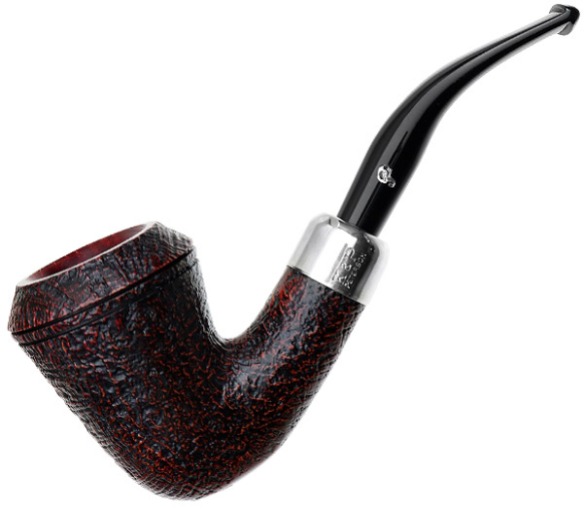 The B60 (Bow), curiously mis-stamped
The B60 (Bow), curiously mis-stamped
for the Arklow line as the XL26 (Hansom)
In any event, the best way for Conor to achieve the catalog breadth Sykes wanted was through sandblasted shapes, which are more readily available than smooths. Like the Derry before it, the Arklow seems to be conceived to allow virtually any shape from the catalog to come and go. Cool idea.
The original idea, Sykes continued, was to have the pipes silver-mounted (like the Lubinski Italian lines), but in the end that pushed costs higher than was thought feasible for the line, so a nickel-mount was decided upon.
2.
Then came the issue of stains. Samples were made up in both a dark ruby and a brown, but it was a toss-up: everyone liked both. Conor brilliantly suggested they go half red and half brown, thereby diversifying the line even more.
 The D20 (POY 2016) Arklow in red and brown
The D20 (POY 2016) Arklow in red and brown
3.
But as the final design concept began to come together, the real coup-de-grace occurred when Jonathan Fields in the workshop suggested the crowns be finished with a smooth deep bevel and stained with a lighter shade of ruby for the red and honey for the brown finish. You can see the penultimate visual design (without the contrasting top color) in the deeply-blasted sample of the B58 below (the Starboard from the original Iceberg series). “But wait,” as they used to say in the old late-night TV ads, “There’s more!”
4.
Finally, Jonathan had the idea that some of shapes be slightly “topped” or shortened, about 2mm to 4mm, it looks like to me. Not all the shapes, just enough to make a Pete Nut’s jaw drop in surprise. This is the first time in the company’s history that anything like this has been done–to consciously alter an established shape. One of the most dramatic examples is the plump brandy transformation of shape 68, seen here.
 68 in the Royal Irish (top) and brown Arklow (bottom)
68 in the Royal Irish (top) and brown Arklow (bottom)
The intense chubby effect produced on the XL90:
pure Peterson muscle
The shape-shifting effect is immediately evident to aficionados, in some cases being quite dramatic. Of course, the smooth sanding of a bottom portion of the bowl to accommodate the laser-stamping – a long-standing Peterson practice – also effects produces some of the shape change, as we’ve seen before in earlier blast lines. Here’s another of my favorite shape-shifters from the first release, the XL20 (Rathbone):
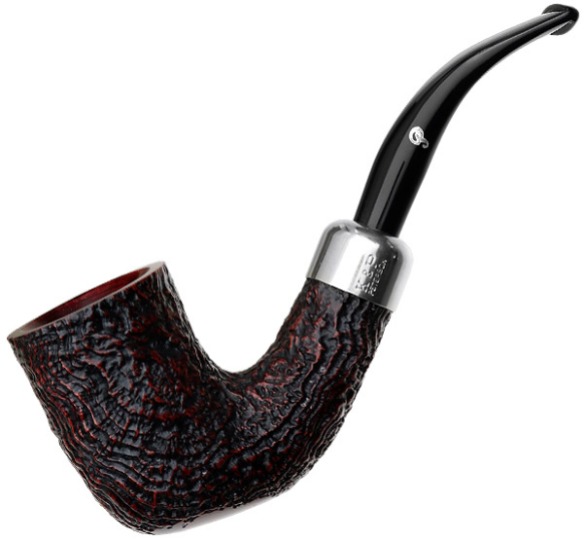 The XL20 (Rathbone) in its Arklow “red” dress
The XL20 (Rathbone) in its Arklow “red” dress
5.
The shorter acrylic fishtail stems with hot foil P also deserve mention, because they’re a departure from classic Peterson house style, some with only a very slight bend and an upward cant at the button. And I have to compliment the button on these acrylics, with their taller shelves, as much easier to clinch than what was being made in the previous generation of acrylic mouthpieces.
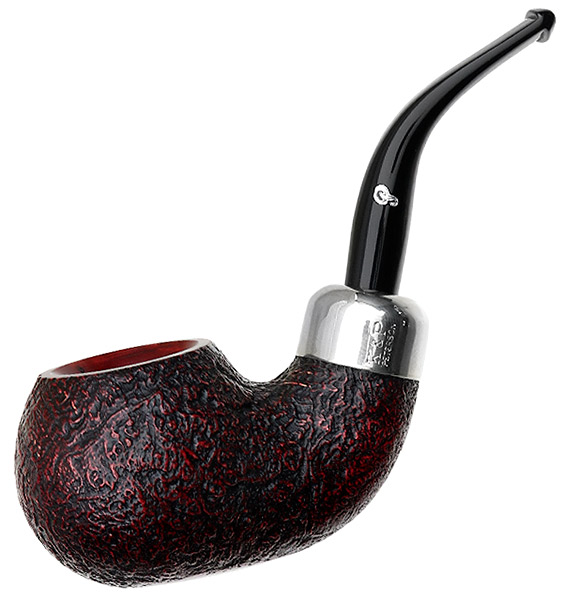 The XL23, already stout, is just plain PHAT in its Arklow “red” dress
The XL23, already stout, is just plain PHAT in its Arklow “red” dress
Sykes told me Smokingpipes has initially received 170 pieces in the Arklow line, and they’re proving very popular. It’s easy to see why. If you see a shape you like, give it some thought, because you might not see it again. When I first saw my beloved XL339 (the 309) shape, I resisted as long as I could – it must have been two, maybe three days (!). When I could stand it no longer, I found it had been sold. When it appeared again the following week, I knew my duty and did it, as you can see in the photo at the bottom.
Thanks to F. Sykes Wilford of Smokingpipes
and Conor Palmer at Peterson
(Photos courtesy Smokingpipes.com & Chas. Mundgunus)



